 In Last October’s issue of Scientific American, authors Mark Z. Jacobson and Mark A. Delucchi plan how the world could derive all of its energy through a combination of renewable wind, water, and solar resources, by 2030.
In Last October’s issue of Scientific American, authors Mark Z. Jacobson and Mark A. Delucchi plan how the world could derive all of its energy through a combination of renewable wind, water, and solar resources, by 2030.
But what does this report add to the discussion on how to make real increases in world-wide renewable energy production? I think that scientists and a large portion of the energy-investment community realize there’s a lot of wind and water in the world, and that the sun shines a lot; the real questions is how to increase the replacement-rate of traditional power systems with renewable power systems. A plan to power the world with 100% renewable energy by 2030 is a nice thought experiment, but it would be nearly impossible to complete in the real-world because existing coal, gas, oil, and nuclear plants represent long-term investments that aren’t going anywhere fast.
Rather than continuing to tout the quantities of potential energy that could be derived from millions of wind-turbines, solar, and geothermal plants built across the world, I think the time has come for scientists, economists, environmentalists, and other activists to focus on regional power systems, and ask where capital investment in renewables could make real in-roads.
Thinking big-picture is wonderful, but to really grab public attention and galvanize investment, the activist community must get more specific. The Rocky Mountain Institute—which assisted in laying some of the groundwork for CEA’s formation—have published several interesting reads on the matter including Negawatt Revolution and Winning the Oil Endgame.
An example of an apparently effective strategy for increasing investment in renewable energy are very large tax incentives. The Modified Accelerated Cost-Recovery System is a depreciation tax incentive that has been on the books for 15 years, but it has not lead to sufficient levels of investment in renewable energy infrastructure. On the other hand, it could be argued that a provision in the Economic Stimulus Package of 2008 which allowed even greater depreciation rates of 50% or more in the first year helped spur the recent growth in wind deployment. Unfortunately, this capacity is largely supplementary and limited by restrictions of an aging grid. It will take even more novel incentives and considerable investment to reach the point where renewables—or efficiency—begin to displace existing power systems.
